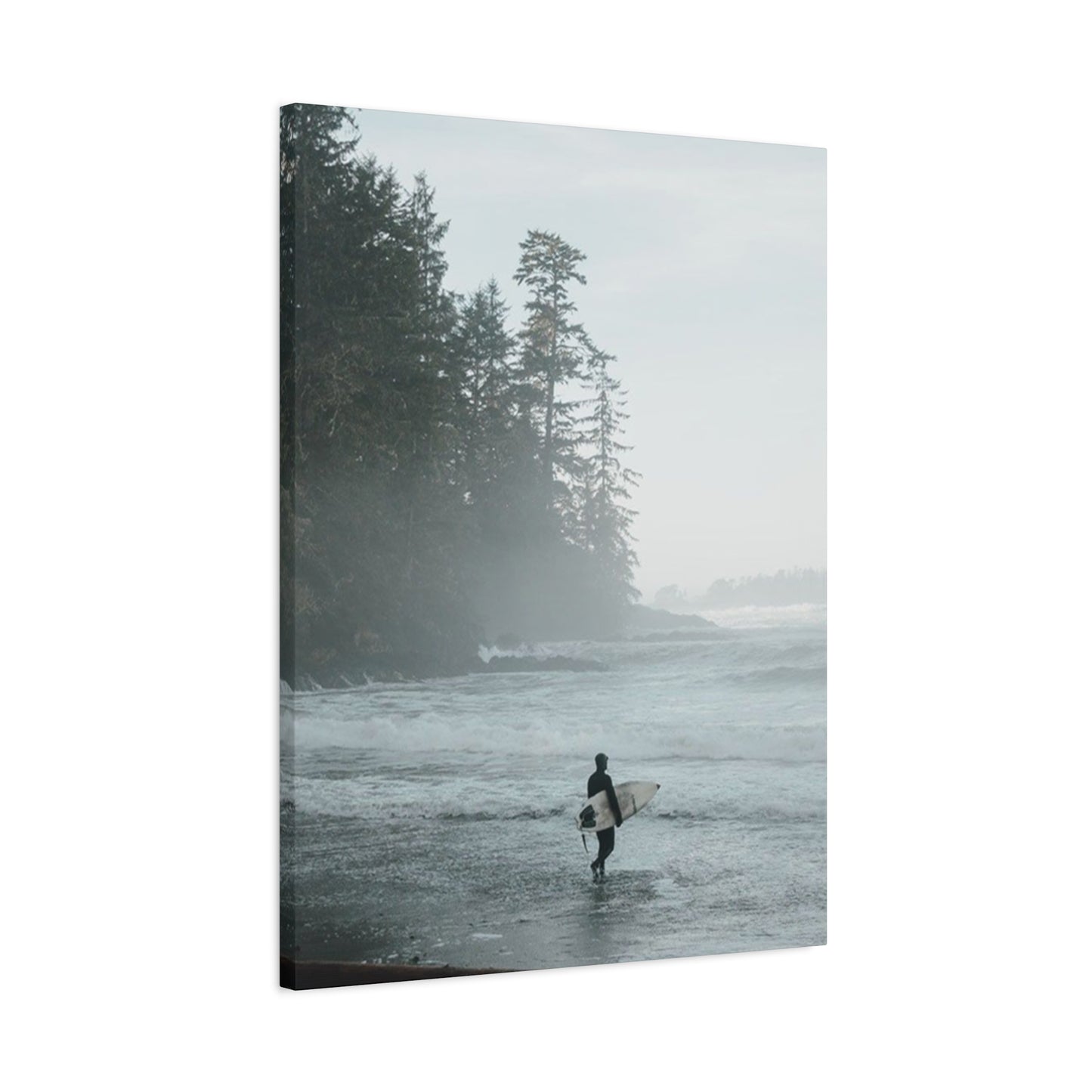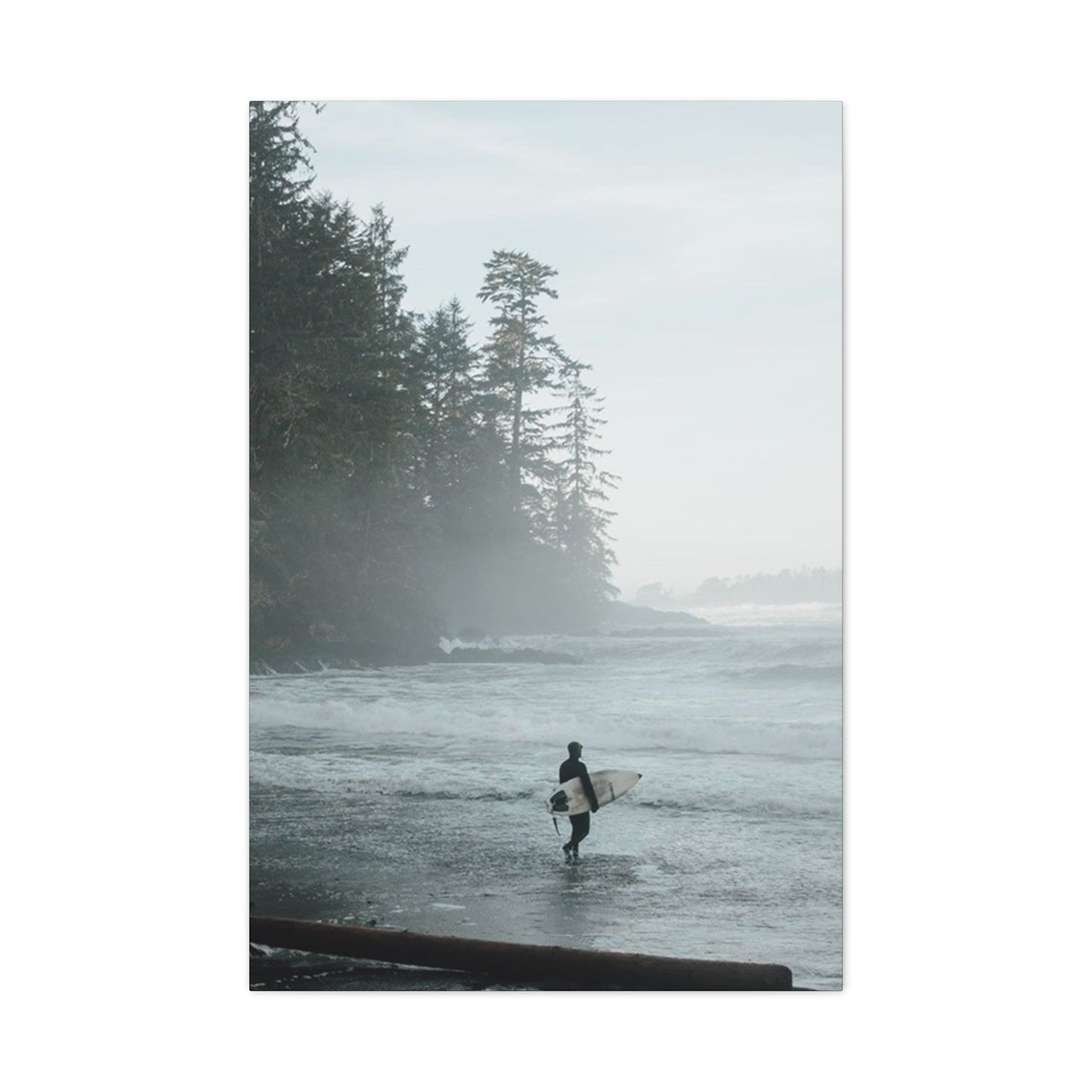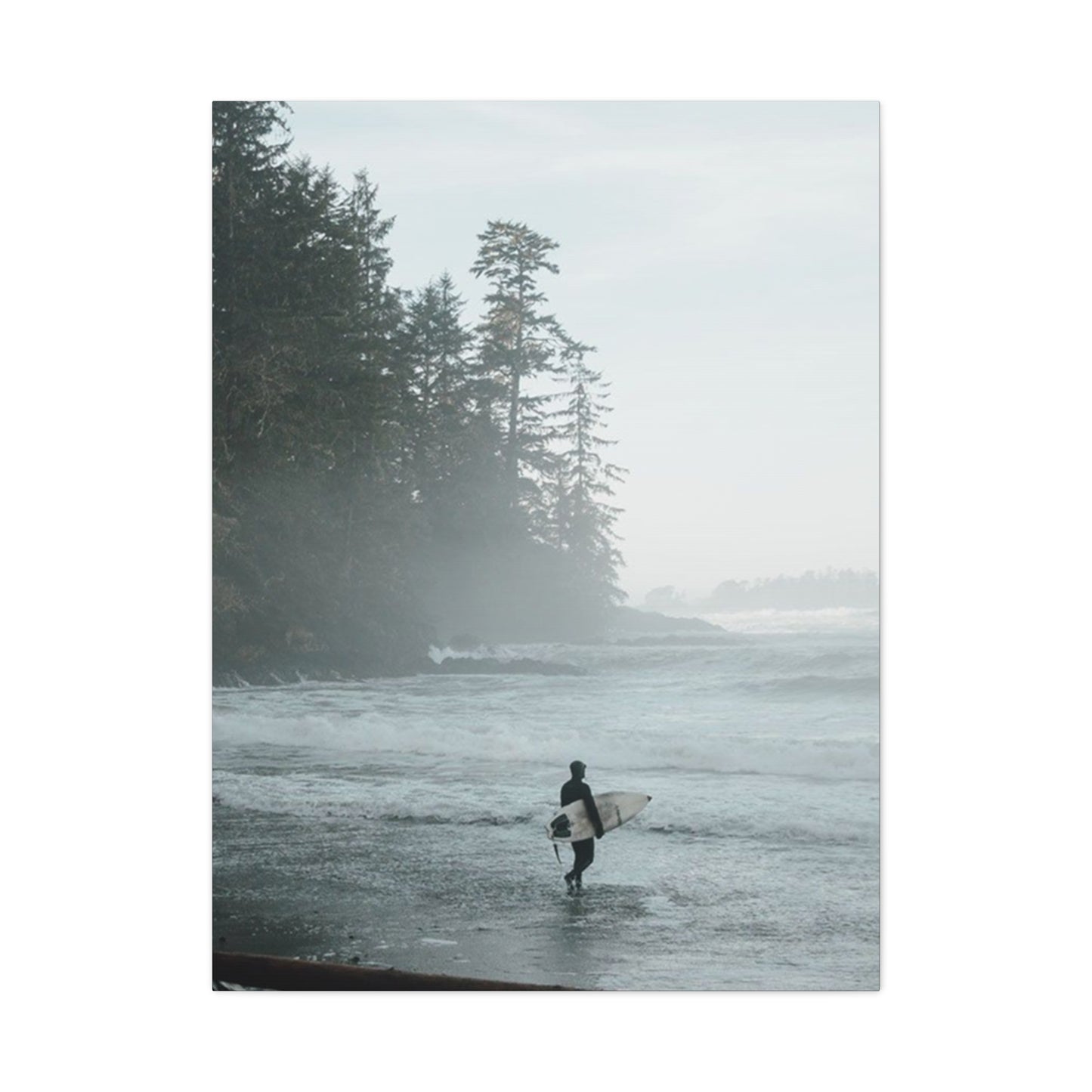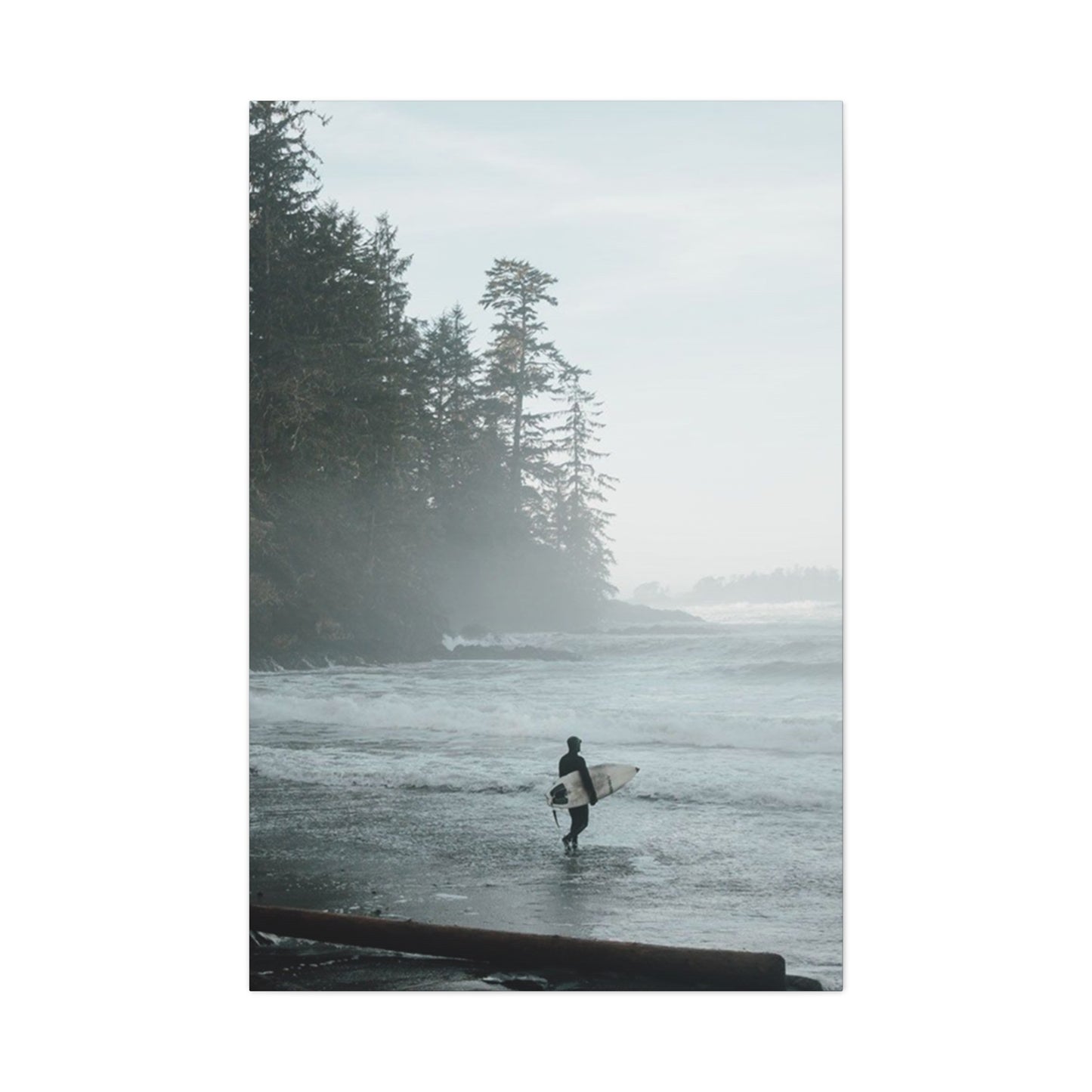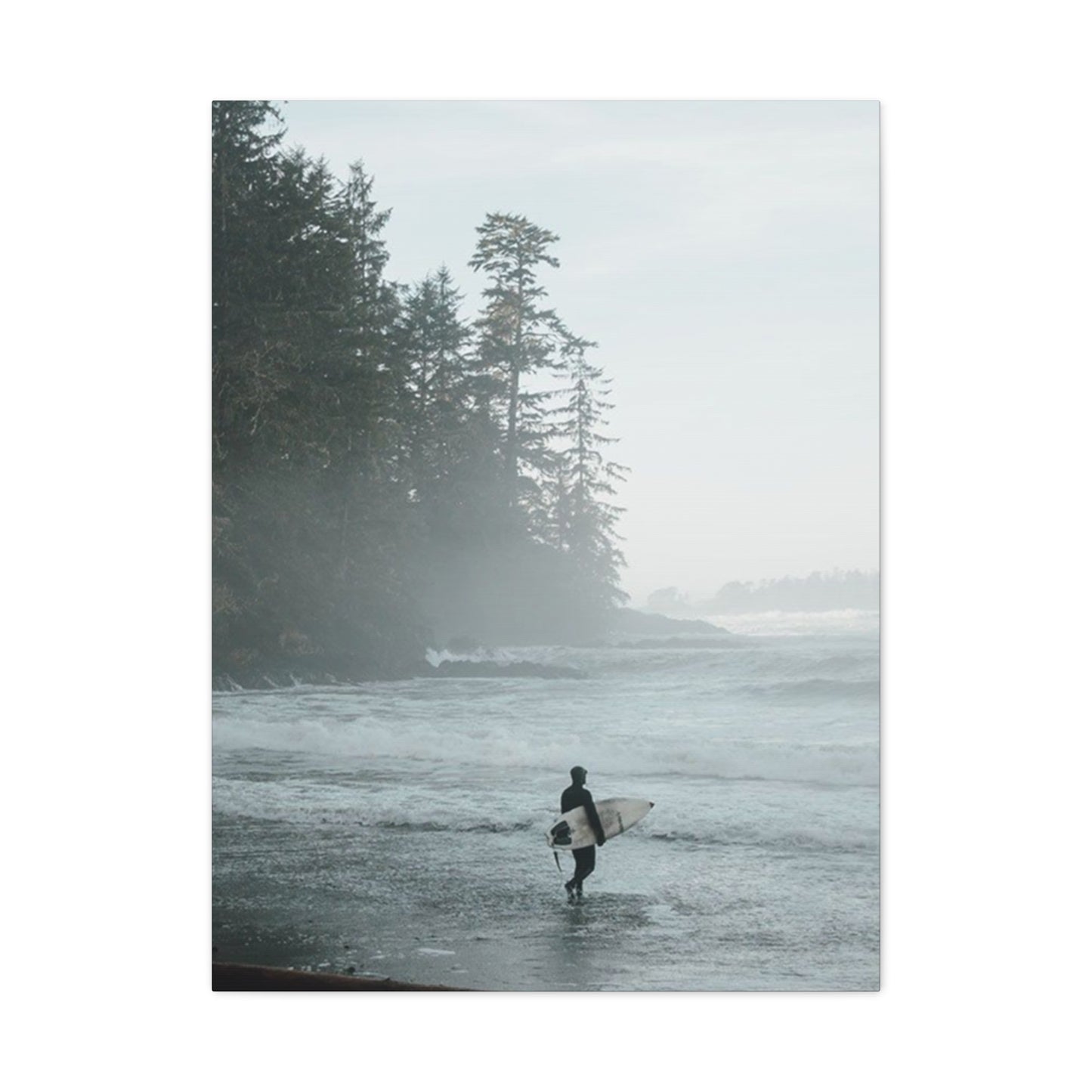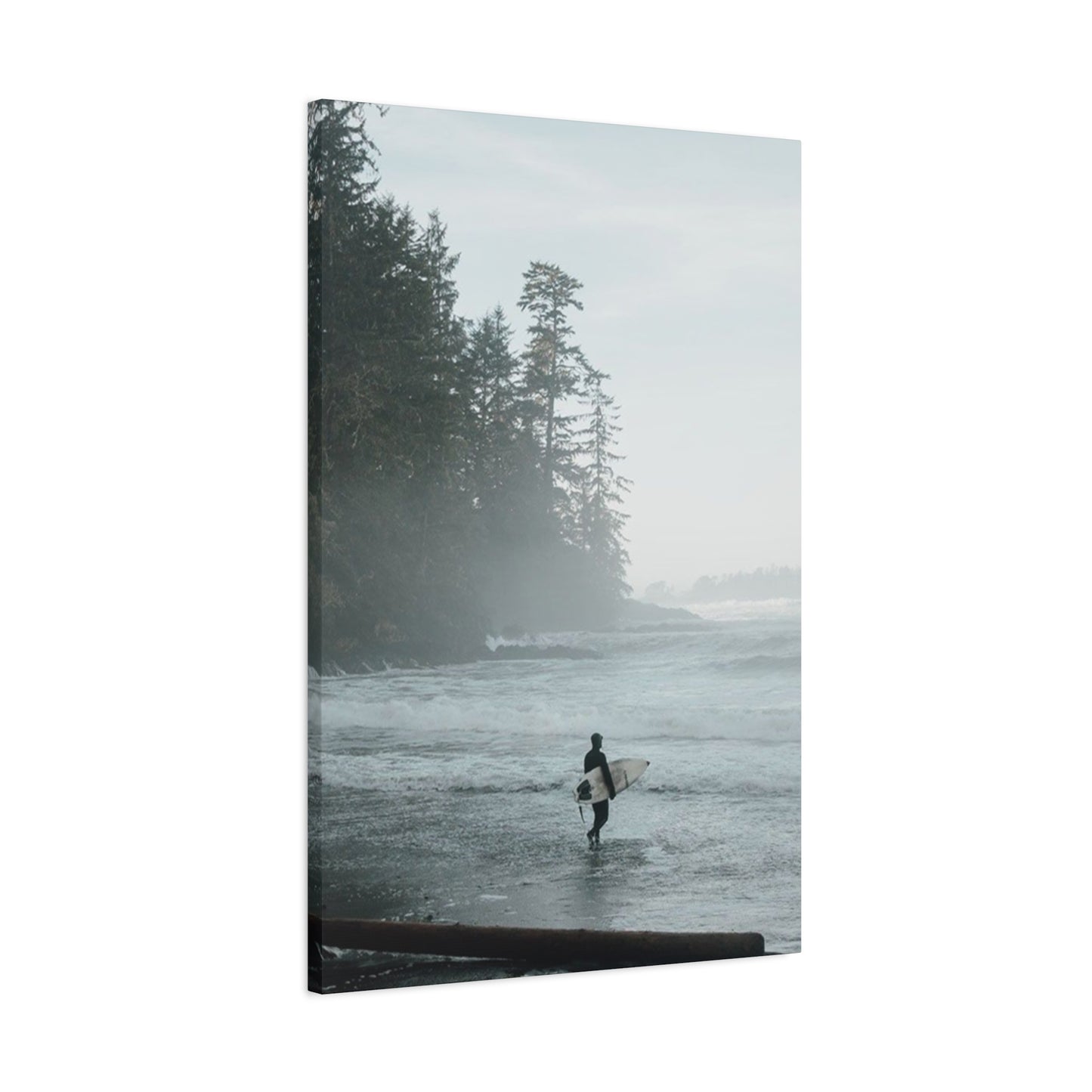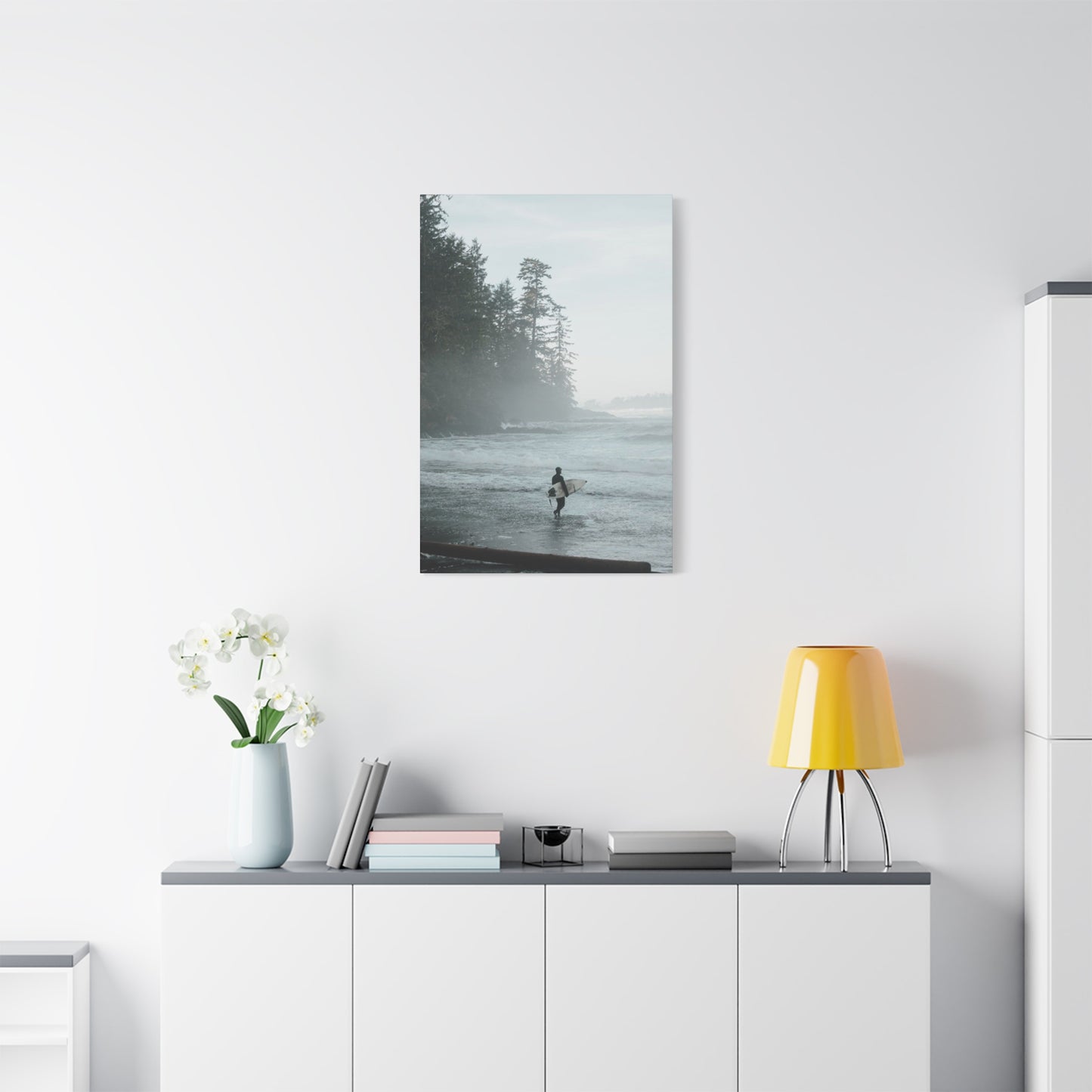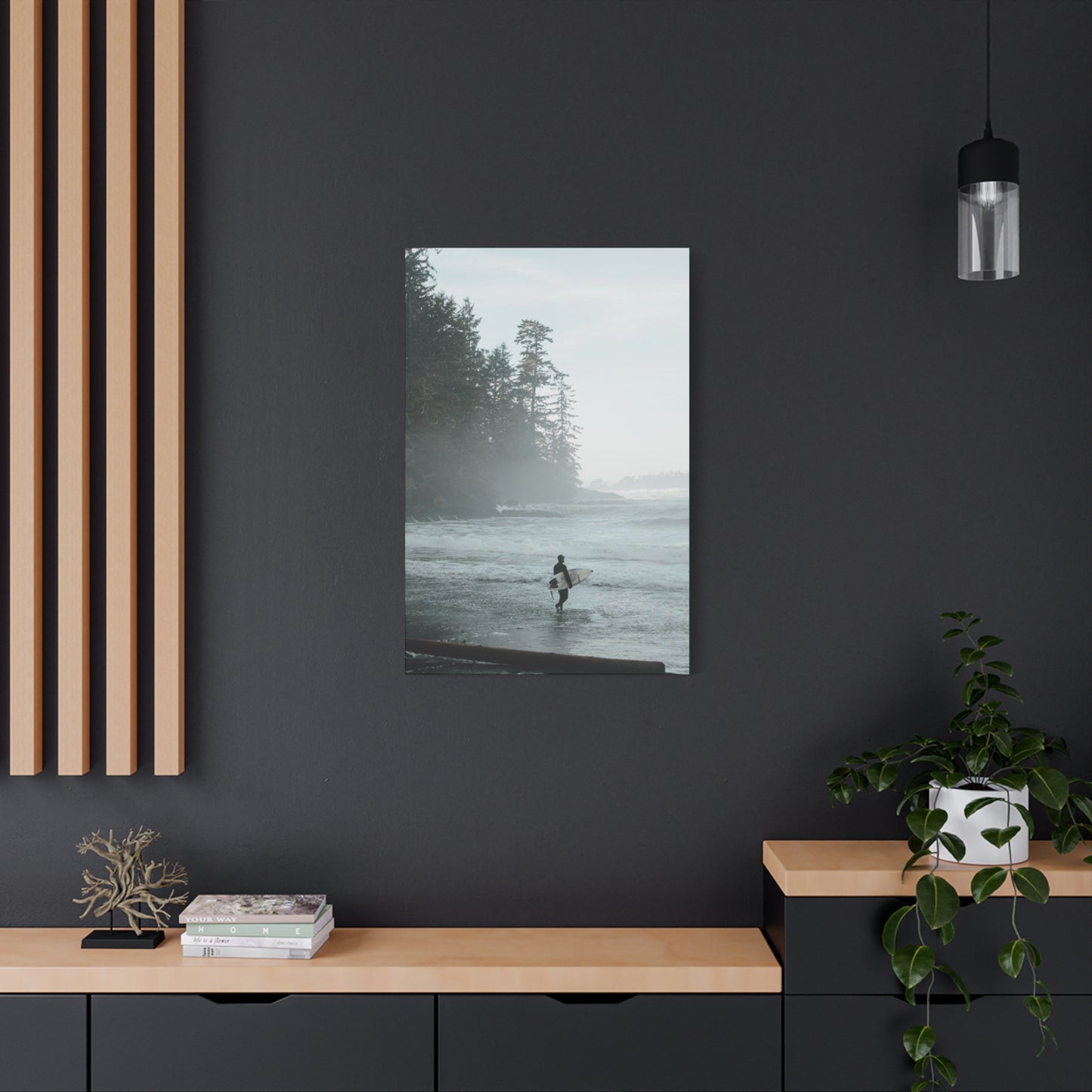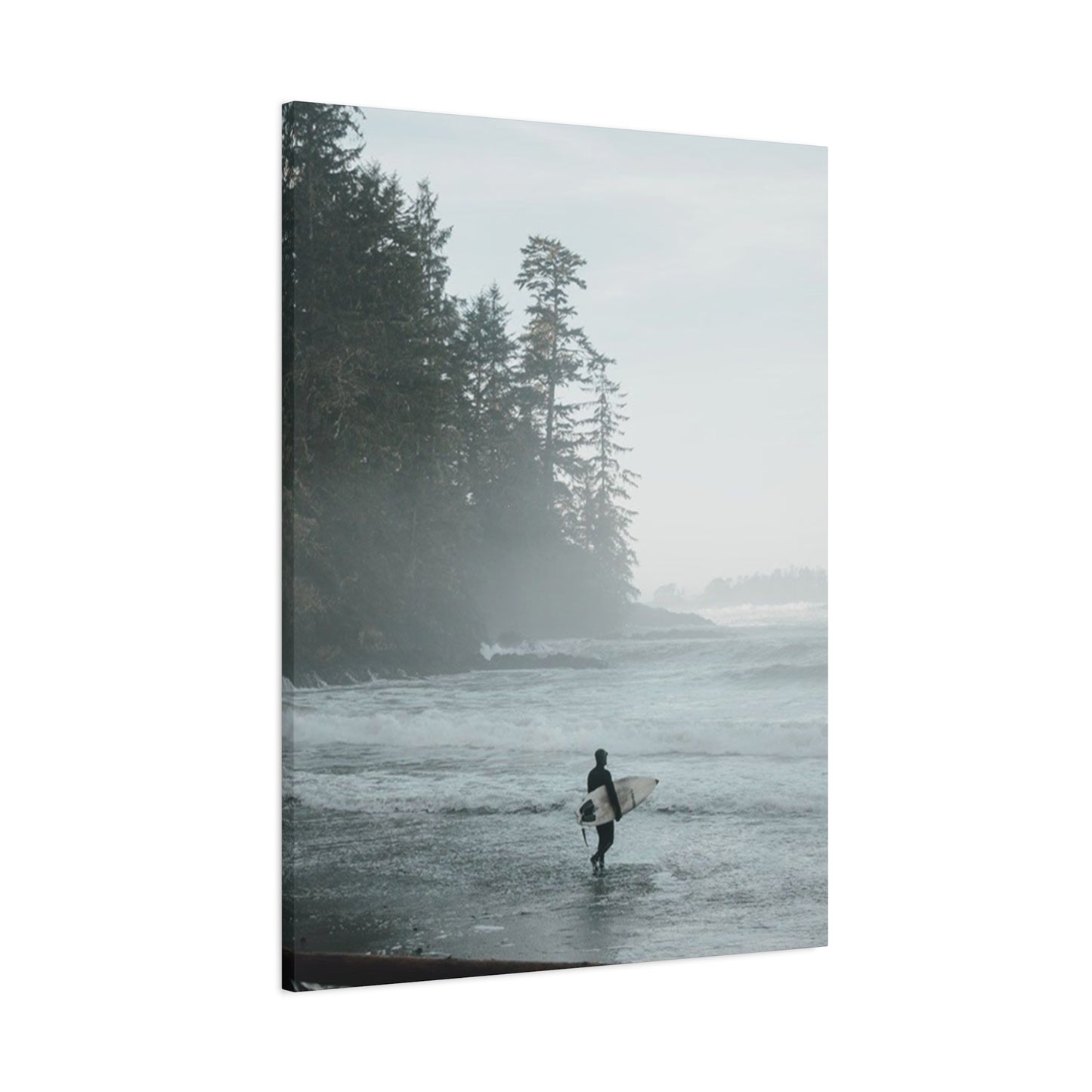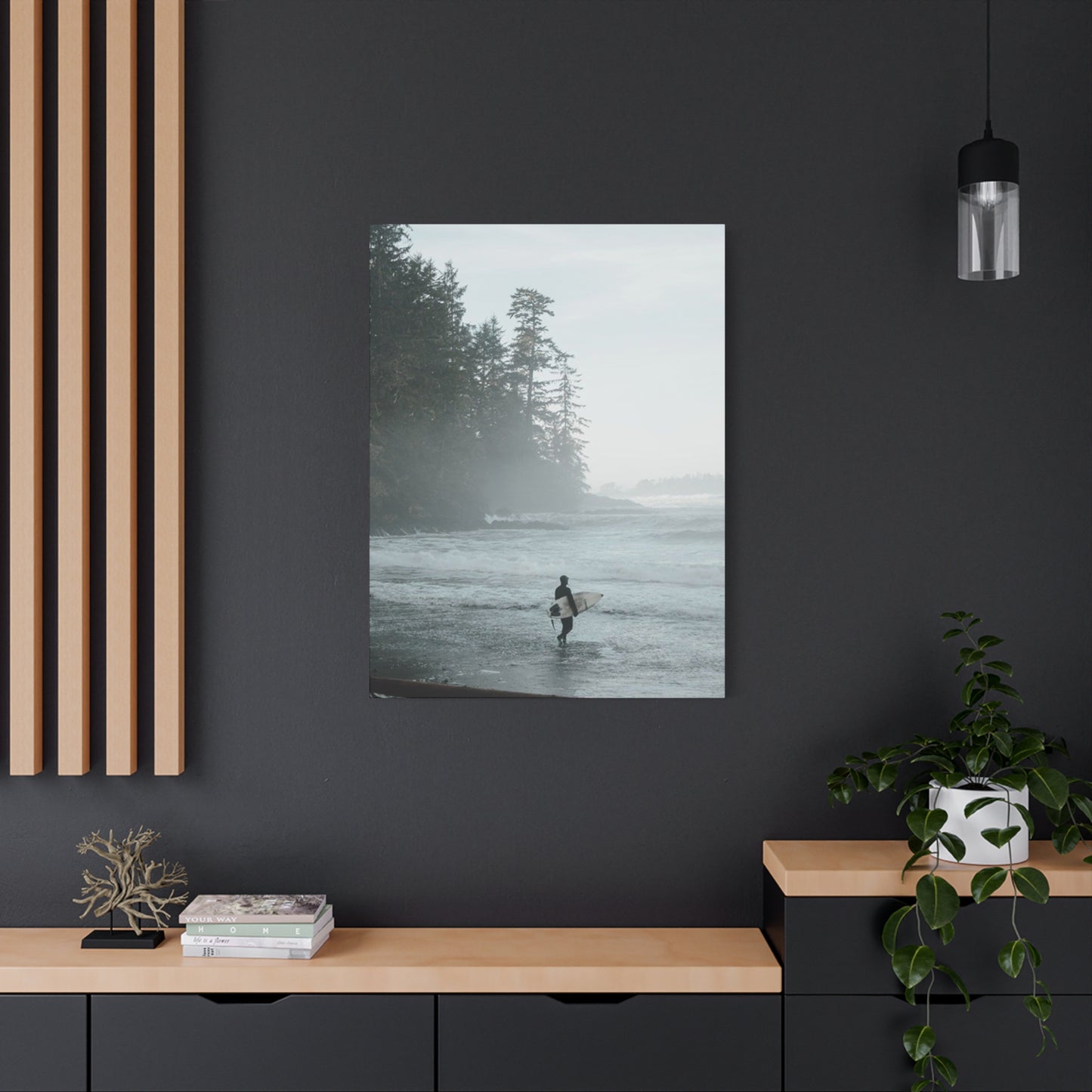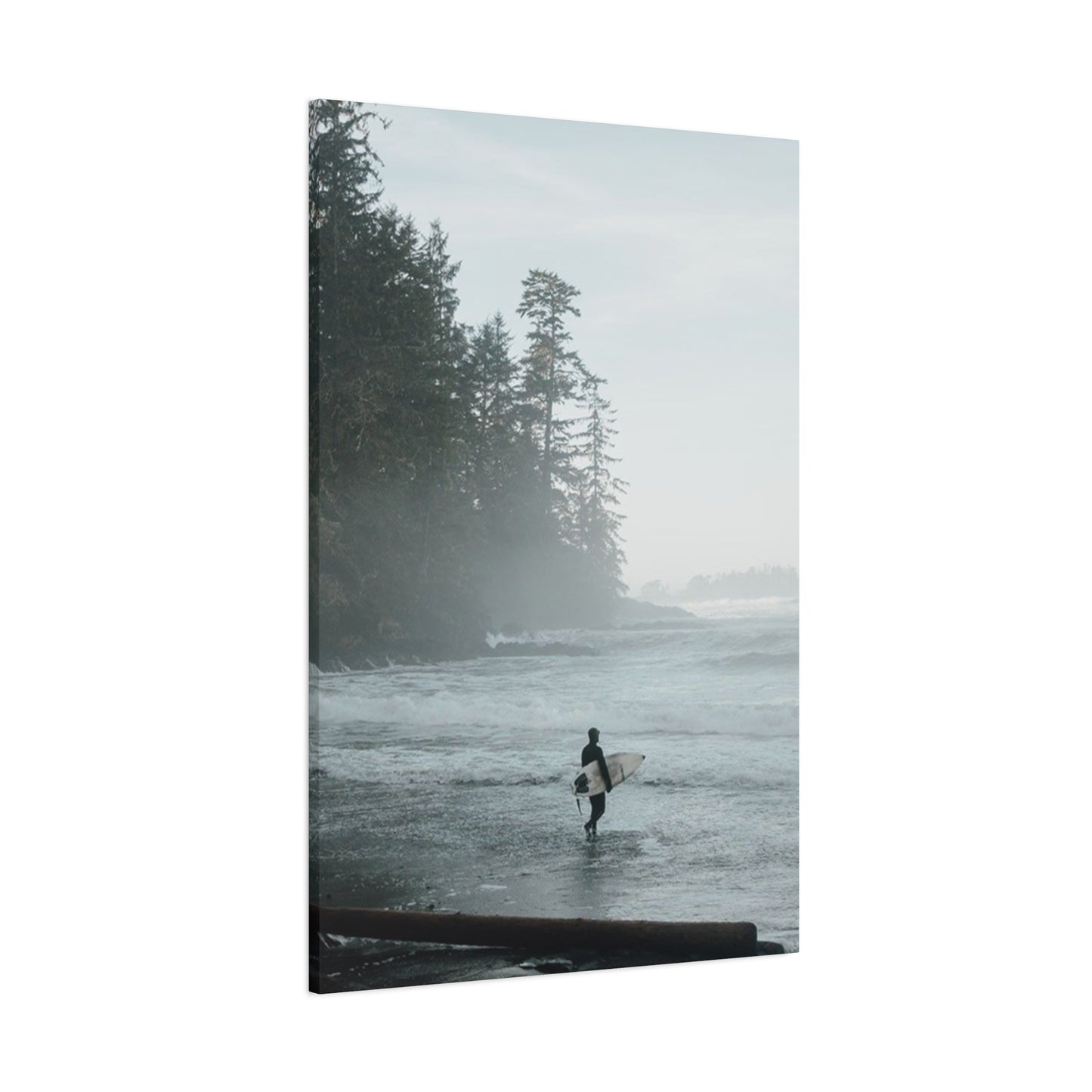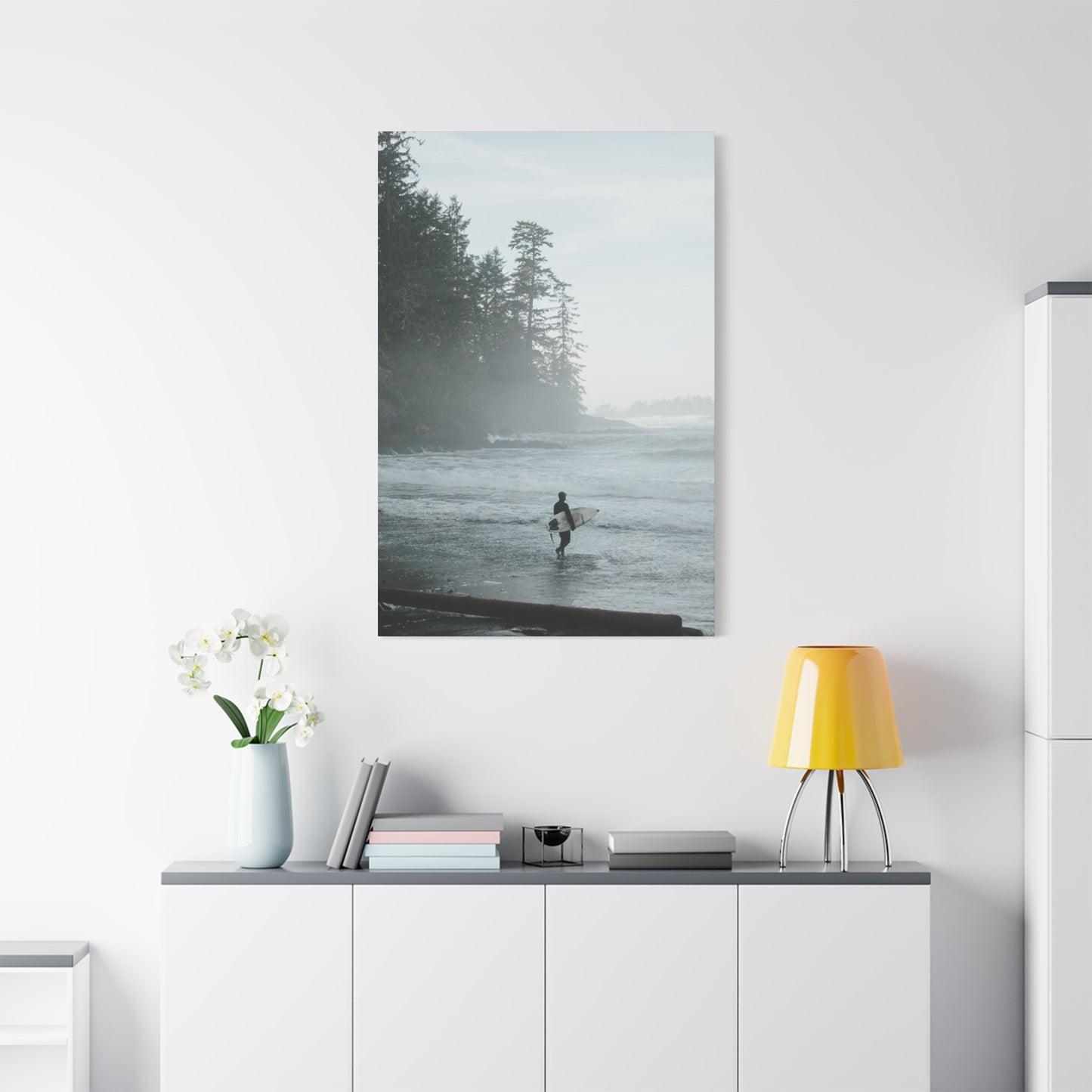Black & White Surfing Poster Wall Art & Canvas Prints
Black & White Surfing Poster Wall Art & Canvas Prints
Couldn't load pickup availability
Monochrome Wave Riders: Capturing Ocean Soul Through Black & White Surfing Photo Wall Art
The timeless appeal of grayscale imagery meets the raw power of ocean waves in a stunning visual medium that transforms living spaces into galleries of aquatic adventure. Black & White Surfing Photo Wall Art represents more than mere decoration; it embodies the pure essence of wave riding, stripped of color distractions to reveal the fundamental drama between human determination and nature's formidable forces. This artistic expression captures fleeting moments when surfers become one with the sea, preserving them in striking contrast that emphasizes texture, motion, and emotion.
The absence of chromatic elements in these photographic pieces redirects viewer attention toward composition fundamentals—the interplay of light and shadow, the sculptural quality of water formations, and the graceful athleticism of riders navigating liquid mountains. When displayed prominently in residential or commercial environments, these works communicate sophistication while celebrating the primal connection between humanity and the ocean's untamed spirit.
The Enduring Charm of Grayscale Ocean Wave Imagery
Monochromatic photography possesses an inherent ability to transcend temporal boundaries, creating visual narratives that feel simultaneously contemporary and classic. When applied to surfing subjects, this aesthetic choice eliminates the ephemeral nature of fashion trends and board designs, focusing instead on universal elements that have defined wave riding since ancient Polynesian cultures first stood upon wooden planks.
The deliberate removal of color information forces both photographer and viewer to engage with structural components that might otherwise go unnoticed. The curve of a breaking wave becomes a study in geometry, while spray caught in backlight transforms into crystalline sculptures frozen in time. Surfers' bodies, reduced to silhouettes or highlighted by strategic illumination, demonstrate human form's remarkable adaptability to challenging environments.
This visual approach honors surfing's authentic character—the sport existed long before vibrant neoprene suits and fluorescent board graphics. By presenting wave riding through a grayscale lens, artists reconnect with the activity's elemental roots, when interaction with the ocean required nothing beyond courage, skill, and respect for natural forces. Such imagery resonates deeply with those who appreciate both athletic prowess and contemplative aesthetics.
Diverse Visual Approaches Within Monochrome Marine Portraiture
The realm of Black & White Surfing Photo Wall Art encompasses remarkable variety despite its chromatic limitations. Some works emphasize documentary realism, capturing authentic moments with photojournalistic precision—a surfer's concentrated expression while paddling toward a massive swell, or the explosive impact when board meets water during a wipeout. These images preserve genuine experiences without artificial staging.
Alternatively, fine art interpretations employ longer exposures or strategic post-processing to create dreamlike atmospheres. Water transforms into silken flows, while moving surfers become ghostly traces across the frame. Such ethereal treatments elevate surfing beyond sport into meditative ritual, suggesting the spiritual dimensions that practitioners often describe but struggle to verbalize.
High-contrast approaches draw inspiration from graphic design principles, reducing scenes to bold shapes defined by stark tonal divisions. These dramatic pieces make powerful statements in minimalist interiors, their simplified forms creating visual anchors that command attention without overwhelming surrounding elements. The technique particularly suits images of surfers against sunset or sunrise backlighting, where bodies become pure silhouettes framed by luminous skies.
Conversely, subtle tonal gradations showcase photography's ability to capture nuanced details across an expanded grayscale range. Such works reveal textures invisible to casual observation—the granular surface of a wave face, the droplets clinging to a surfer's wetsuit, or the fine mist suspended above churning whitewater. These images reward prolonged viewing, revealing new layers with each examination.
Material Substrates and Their Impact on Visual Presentation
The physical medium chosen for displaying monochrome surfing imagery significantly influences its final aesthetic impact. Canvas prints offer textured surfaces that complement the organic nature of water subjects, while their wrapped edges eliminate the need for framing, creating contemporary gallery-style presentations. The fabric's slight tooth adds tactile dimension that enhances the handcrafted quality many collectors seek.
Metal prints represent a modern alternative that generates stunning results with ocean subjects. The aluminum substrate's reflective properties create luminous depth, particularly effective for images featuring backlit spray or glassy water conditions. The medium's inherent resistance to moisture makes it especially appropriate for beach houses or humid coastal environments where traditional paper prints might deteriorate.
Acrylic face mounting produces jewel-like clarity with extraordinary dimensional depth. When monochrome surfing images receive this treatment, the protective acrylic layer creates a sense of peering through a window into the scene. Light refracts through the transparent surface, animating the image with environmental illumination changes throughout the day. This premium presentation method suits large-format pieces intended as focal points in refined spaces.
Traditional fine art paper prints maintain relevance for collectors who value archival qualities and classic presentation aesthetics. Baryta-coated papers, originally developed for analog photography, deliver exceptional tonal range and subtle surface sheen that beautifully renders the gradations in wave forms and atmospheric conditions. Framing these prints behind museum-quality glass with acid-free matting ensures preservation while adding formal elegance appropriate for traditional interior schemes.
Compositional Strategies That Elevate Ocean Imagery
Successful Black & White Surfing Photo Wall Art employs deliberate compositional techniques that guide viewer attention and create visual narratives. The rule of thirds, while sometimes considered elementary, proves remarkably effective when positioning surfers within the frame—placing the rider at an intersection point generates natural visual tension while allowing the surrounding seascape to provide context.
Leading lines created by wave contours, board trajectories, or horizon positions draw eyes through the composition, creating movement within the static image. A well-positioned surfer riding across the frame generates directional energy that makes the photograph feel dynamic rather than frozen. The negative space around subjects—whether empty sky or unbroken water—provides breathing room that prevents visual claustration while emphasizing the vastness of the marine environment.
Scale relationships between surfers and waves communicate crucial narrative information. A small figure dwarfed by a towering face conveys the magnitude of nature's power and the courage required to challenge it. Conversely, tighter framing that shows intimate details of a rider's technique emphasizes human skill and control, shifting the story from confrontation to mastery.
Symmetry and pattern recognition satisfy innate human preferences for visual order. Images capturing perfectly formed barrel sections or repeating wave sets appeal to our appreciation for natural geometry. Breaking this symmetry with asymmetrical surfer placement creates productive tension between order and disruption, mirroring the sport's fundamental nature as controlled chaos.
Illumination Conditions That Define Grayscale Character
Lighting circumstances during capture fundamentally determine a monochrome image's ultimate character and emotional resonance. Dawn and dusk hours provide the dramatic sidelighting that creates pronounced shadows and highlights, rendering three-dimensional form clearly even without color cues. During these golden hour periods (which retain their descriptive name despite producing merely tonal values in grayscale), the low sun angle rakes across wave surfaces, revealing every ripple and texture.
Overcast conditions, often dismissed by color photographers, offer unique advantages for monochrome marine work. The diffused skylight eliminates harsh shadows while providing even illumination that reveals subtle tonal gradations. Such conditions prove ideal for capturing the meditative quality of solitary surfers in fog-shrouded lineups or documenting the texture-rich surfaces of storm-driven seas.
Backlighting situations create the dramatic silhouettes that have become iconic within surfing imagery. When the sun positions directly behind a breaking wave or airborne rider, the subject becomes a stark shape defined entirely by outline. These high-contrast images reduce scenes to their essential elements, creating graphic compositions with immediate visual impact.
Underwater perspectives present unique illumination challenges and opportunities. Sunlight penetrating the ocean surface creates caustic patterns and directional beams that appear especially dramatic in grayscale. Images of surfers duck-diving beneath waves or viewed from below while riding overhead reveal perspectives rarely witnessed, their novelty commanding viewer attention.
Emotional Resonance in Monochromatic Wave Riding Imagery
Black & White Surfing Photo Wall Art possesses distinctive emotional qualities that distinguish it from color alternatives. The grayscale palette tends toward introspection, inviting contemplative engagement rather than immediate sensory stimulation. Viewers often report that monochrome ocean images feel more serious, timeless, and profound—qualities aligning with surfing's philosophical dimensions.
The stark contrast and simplified tonal range can amplify drama and tension. A massive wave rendered in grayscale may appear more threatening than its colorful counterpart, as the eye focuses exclusively on the water's sculptural mass and power rather than being distracted by blue hues. This intensification effect makes monochrome particularly effective for capturing extreme surfing conditions or moments of peak athletic performance.
Conversely, high-key images with predominantly light tones evoke serenity and weightlessness. Foggy dawn patrols or summer afternoon sessions can be rendered as ethereal experiences, with barely-there tonal transitions suggesting the liminal state many surfers describe when fully immersed in wave riding flow. These softer interpretations appeal to those seeking calming influences within their living environments.
The nostalgic quality inherent to grayscale imagery connects contemporary surfing with its documented past. Much early surf photography necessarily occurred in monochrome due to film availability and reproduction limitations. Modern grayscale work taps into this visual heritage, creating continuity across decades while honoring the pioneers who first captured wave riding on film.
Curation Principles for Multiple Piece Arrangements
Assembling collections of Black & White Surfing Photo Wall Art requires thoughtful consideration to achieve visual cohesion without monotony. Varying image scales within a grouping creates hierarchy and rhythm—a large central piece flanked by smaller supporting images draws focus while maintaining interest across the entire arrangement. This approach mimics musical composition, with dominant themes and supporting harmonies.
Maintaining consistent framing styles or print methods across a collection unifies disparate images. Whether choosing uniform black frames, natural wood tones, or frameless canvas wraps, this repetition creates visual threads connecting individual pieces into a coherent whole. Conversely, deliberately mixing presentation styles can generate eclectic energy suitable for casual spaces or studios.
Thematic consistency strengthens narrative impact. A collection might focus exclusively on barrel sections, creating an immersive study of this particular wave formation's variations. Alternatively, following a single surfer through various maneuvers tells a personal performance story. Geographic consistency—all images from one renowned surf break—educates viewers about that location's unique characteristics while building sense of place.
Tonal variation prevents visual stagnation when displaying multiple monochrome pieces together. Alternating between high-contrast dramatic images and softer, more subtle works creates visual breathing patterns that guide eyes around the arrangement without exhaustion. This principle mirrors musical dynamics, preventing relentless fortissimo that would overwhelm listeners.
Geographic Distinctions in Ocean Wave Photography
Different coastal regions produce distinctive wave characteristics that significantly influence the aesthetic of Black & White Surfing Photo Wall Art originating from those locations. The tropical Pacific generates warm-water barrels with crystalline formations, their geometric perfection appearing almost artificial in their consistency. These waves photograph with clean lines and smooth textures, creating orderly compositions.
Cold-water environments produce different visual signatures. The North Atlantic's storm swells generate chaotic energy with wind-blown spray and irregular formations. These conditions yield gritty, raw imagery that communicates the harsh realities of surfing in frigid temperatures. The heavier wetsuits, gloves, and hoods worn in such locations add textural elements and bulk that alter surfers' visual profiles compared to tropical equivalents.
Point breaks, where waves wrap around headlands in consistent fashion, provide opportunities for capturing repeated forms with predictable characteristics. Photographers working these locations can anticipate optimal positioning and lighting conditions, resulting in technically refined images that showcase both natural and human performance at peak levels.
Beach breaks generate more variable conditions with sections reforming unpredictably. This inconsistency produces spontaneous, energetic imagery that captures surfing's improvisational nature. The lack of uniformity challenges both surfers and photographers, resulting in authentic moments that reflect the sport's adaptive requirements.
Historical Evolution of Surfing's Visual Documentation
The visual representation of wave riding has transformed dramatically since Hawaiians first stood on wooden olo boards centuries ago. Early Western documentation occurred through paintings and illustrations as explorers encountered Polynesian surf cultures. These artistic interpretations emphasized exotic novelty, often exaggerating proportions and misrepresenting techniques.
Photography's invention enabled authentic documentation, though early equipment limitations restricted surf photographers to shore-based perspectives with long lenses. These distant viewpoints created dramatic scale relationships but missed intimate action details. The imagery from this era, necessarily monochrome, established visual conventions that continue influencing contemporary Black & White Surfing Photo Wall Art—the small figure against massive waves, the silhouetted rider, the perfect barrel viewed from the channel.
Water housing development revolutionized surf photography by enabling in-the-lineup and underwater perspectives. Suddenly photographers could document the surfer's view, capturing the immediate environment and the rider's expressions during critical moments. This intimacy transformed surfing imagery from distant observation to participant experience, fundamentally altering how audiences engaged with the subject.
The shift from film to digital capture eliminated many practical constraints, allowing photographers to shoot thousands of frames during single sessions without reloading concerns. However, this abundance created new curation challenges—sorting through massive image libraries to identify truly exceptional moments requires refined editorial judgment that the film era forced through economic necessity.
The Photographer's Craft Behind Exceptional Ocean Imagery
Creating gallery-worthy Black & White Surfing Photo Wall Art demands specialized skills extending far beyond basic camera operation. Successful surf photographers develop intimate knowledge of ocean dynamics, learning to read swell patterns, wind effects, and tidal influences that determine when and where exceptional waves will appear. This environmental literacy separates compelling documentation from random snapshots.
Physical fitness and water safety competence prove essential for in-the-water work. Photographers must paddle into impact zones, often in challenging conditions, while protecting expensive equipment from salt, sand, and violent impacts. The ability to duck-dive beneath approaching waves while maintaining camera housing integrity requires practiced technique and protective gear specifically designed for aquatic photography.
Anticipation and timing distinguish professional-level surf photography from amateur efforts. The critical moment when a surfer executes a maneuver lasts mere fractions of seconds. Photographers must predict these instants before they occur, pre-focusing and framing to capture peak action. This prescient ability develops through experience and deep understanding of surfing's biomechanics.
Post-capture processing significantly influences final image character, particularly for monochrome work. Converting color files to grayscale involves choices about tonal relationships and channel mixing that determine whether skies appear dramatic or subdued, whether water textures emerge crisply or recede softly. Dodging and burning techniques inherited from darkroom traditions selectively lighten or darken regions, guiding viewer attention and enhancing compositional structure.
Architectural Contexts That Complement Marine Imagery
Black & White Surfing Photo Wall Art integrates successfully into diverse interior design schemes, though certain architectural contexts particularly enhance its impact. Coastal modernist spaces with clean lines, neutral palettes, and abundant natural light provide ideal environments. The imagery's organic subjects contrast productively with geometric architecture, while the monochrome palette harmonizes with minimalist color schemes.
Industrial loft spaces benefit from the raw energy of dramatic surf photography. Exposed brick, concrete floors, and visible ductwork create textural backgrounds against which oceanic imagery provides thematic counterpoint—natural versus manufactured, fluid versus solid, organic versus constructed. Large-format pieces spanning multiple feet command attention in these high-ceiling environments.
Traditional interiors surprisingly accommodate grayscale surf imagery when framing and matting receive careful consideration. Pairing ocean scenes with classic moldings and substantial wooden frames bridges stylistic gaps, allowing contemporary subjects to coexist with period architecture. The key lies in respecting both the image's character and the space's established aesthetic rather than forcing incongruous combinations.
Corporate environments increasingly feature surf photography as businesses recognize that workplace atmosphere influences employee wellbeing and productivity. Conference rooms and collaborative spaces benefit from images suggesting freedom, adventure, and natural connection—qualities that counterbalance the constraints of office routines. The neutral palette of monochrome work prevents color clashes with corporate branding while maintaining professional appearance.
Dimensions and Scaling Considerations for Maximum Impact
The physical size of Black & White Surfing Photo Wall Art dramatically affects its presence and viewer engagement. Oversized pieces measuring five feet or more in width create immersive experiences that place viewers within the scene. These statement works suit spacious rooms where sufficient viewing distance allows comfortable perception of the entire image. At appropriate scale, such pieces become experiential rather than merely decorative.
Medium-sized works ranging from two to four feet offer versatility for varied spaces. They provide significant visual impact without overwhelming modest rooms, and multiple pieces at this scale can be arranged in compelling groupings. This size range proves particularly effective for residential installations where architectural features like doorways and windows create natural breaks in available wall space.
Smaller pieces, while less dramatic individually, excel in curated collections or gallery walls mixing surf imagery with other subjects. These intimate works reward close examination, their modest scale encouraging viewers to step near and study details. They suit personal spaces like home offices or bedrooms where contemplative engagement replaces the public impact of larger installations.
Aspect ratio selection influences compositional effectiveness and architectural compatibility. Horizontal orientations emphasize the ocean's expanse and suit wider wall spaces, while vertical formats complement narrow areas and door sides. Square compositions provide balanced neutrality that adapts to various situations, though they sacrifice some dynamic energy that rectangular formats generate through directional emphasis.
The Collector's Journey in Acquiring Ocean Imagery
Building a meaningful collection of Black & White Surfing Photo Wall Art involves considerations beyond aesthetic preference. Limited edition prints carry scarcity value, with photographers restricting production runs to specific quantities. Editions numbered and signed by artists typically command premium prices but offer potential appreciation as pieces sell out and secondary market activity begins.
Open edition works provide affordability for emerging collectors or those furnishing multiple spaces. While lacking investment potential of limited releases, they deliver identical visual impact when displayed. The democratic accessibility of unlimited reproductions allows wider audiences to enjoy exceptional imagery without financial barriers that exclude many from art ownership.
Provenance and authenticity documentation protect collectors from reproductions or unauthorized duplicates. Certificates of authenticity, purchase receipts, and photographer signatures establish legitimate ownership chains. As surf photography gains recognition within fine art markets, proper documentation becomes increasingly important for insurance purposes and potential resale.
Direct artist purchases support photographers while often providing acquisition advantages. Buying from creators eliminates gallery markups while establishing relationships that may yield access to new work before public release. Many photographers offer portfolio reviews or custom printing services for collectors seeking specific sizes or treatments unavailable through standard channels.
Environmental Storytelling Through Monochrome Marine Works
Beyond aesthetic considerations, Black & White Surfing Photo Wall Art can communicate important narratives about ocean health and environmental stewardship. Images of pristine lineups remind viewers of natural beauty requiring protection, while works depicting remote locations highlight wilderness areas threatened by development or climate impacts.
Subtle environmental statements emerge through image selection and presentation. A series showing seasonal variations at a single break documents natural cycles while implying the disruptions that climate change introduces. Images capturing surfers in uncrowded conditions celebrate increasingly rare experiences as population growth and surf tourism concentrate participants at known breaks.
The monochrome medium's timeless quality suits conservation messaging by suggesting permanence and endurance. Color imagery can feel ephemeral and trend-dependent, while grayscale work implies unchanging values and long-term perspectives. This subliminal messaging reinforces conservation themes without requiring explicit didactic content.
Some photographers explicitly donate proceeds from certain images toward marine conservation organizations, allowing collectors to support causes aligned with their values through art acquisition. This intersection of aesthetics and activism appeals to socially conscious buyers seeking meaningful connections to their purchases beyond decorative function.
The Marketplace Landscape for Ocean Photography
The commercial environment for Black & White Surfing Photo Wall Art spans diverse channels serving varied customer segments. High-end galleries in coastal markets curate surf photography alongside other fine art forms, validating the medium's legitimacy within established art world structures. These venues provide white-wall presentation contexts and educated sales staff who articulate artistic merit to serious collectors.
Online marketplaces democratize access while enabling photographers to reach global audiences without geographic limitations. Direct-to-consumer platforms eliminate intermediary markups, making premium imagery accessible to broader demographics. Virtual gallery tools allowing customers to visualize specific pieces within their spaces address the traditional limitation of purchasing art sight-unseen.
Surf industry retail channels introduce photography to enthusiast audiences already invested in wave riding culture. Surf shops displaying local photographers' work create synergistic relationships—surfers furnish homes with images reflecting their passion while supporting artists documenting their community. This grassroots distribution maintains cultural authenticity sometimes lost when surf imagery enters mainstream fine art markets.
Licensing arrangements allow exceptional surf images to appear on varied products beyond wall art—book covers, magazine features, commercial advertisements, and digital applications. While these uses may not substitute for original print ownership, they expand photographers' revenue streams while increasing public exposure to their work, potentially building name recognition that enhances demand for limited edition releases.
Printing Methods That Preserve Image Integrity
The reproduction process significantly impacts how Black & White Surfing Photo Wall Art appears when displayed. Giclée printing, using archival pigment inks and fine art papers, produces gallery-quality results with exceptional tonal range and longevity. This museum-standard method ensures prints resist fading for decades when properly displayed, protecting collectors' investments through time.
Traditional darkroom printing, though increasingly rare, offers unique qualities that digital processes cannot perfectly replicate. Analog prints exhibit subtle tonal transitions and organic grain structures resulting from chemical development on light-sensitive paper. Limited availability of darkroom-printed surf photography enhances collectibility for those valuing handcrafted processes and tangible connections to photographic traditions.
Dye-sublimation transfers onto metal or fabric substrates employ heat to bond inks permanently with receiving materials. This process creates durable prints resistant to scratching, moisture, and UV degradation—practical advantages for coastal installations where humidity and sunlight pose preservation challenges. The molecular bonding ensures image permanence exceeding many traditional printing methods.
Direct-to-substrate UV printing deposits inks onto varied materials—wood panels, glass, or acrylic—through precision nozzles while simultaneously curing with ultraviolet light. This versatile method enables printing on three-dimensional or textured surfaces, expanding creative presentation possibilities. The immediate curing produces vibrant results with excellent durability and weather resistance.
Curatorial Voices Interpreting Surf Photography's Significance
Art world recognition of surf photography as legitimate fine art has grown substantially over recent decades, with major institutions now regularly featuring ocean imagery in exhibitions. This acceptance validates photographers who long insisted their work transcended mere sports documentation, constituting genuine artistic expression worthy of serious critical consideration.
Scholarly analysis examines surf photography through various theoretical frameworks—formalist approaches focusing on compositional excellence, environmental criticism exploring human-nature relationships, or cultural studies investigating surf culture's broader societal meanings. These multiple interpretive lenses enrich appreciation by revealing layers of significance beyond surface aesthetics.
Feminist critique addresses historical gender imbalances within surf photography, which traditionally focused almost exclusively on male surfers while marginalizing women riders. Contemporary photographers increasingly document female surfers with equivalent respect and coverage, expanding representation while challenging stereotypical portrayals. This corrective effort parallels broader cultural reckonings regarding gender equity across various domains.
Indigenous perspectives offer crucial insights into surf culture's Polynesian origins and the complex dynamics of cultural appropriation versus appreciation. Hawaiian scholars particularly emphasize how wave riding's spiritual dimensions and cultural protocols often get overlooked when surfing enters mainstream commodification. Black & White Surfing Photo Wall Art that respects these roots while acknowledging modern evolutions demonstrates cultural sensitivity alongside aesthetic merit.
Lighting Strategies for Optimal Display Presentation
Proper illumination dramatically influences how Black & White Surfing Photo Wall Art appears within interior spaces. Natural daylight provides ideal viewing conditions, revealing the full tonal range and subtle gradations that quality prints contain. Positioning artwork opposite windows rather than directly beneath them prevents glare while allowing reflected ambient light to illuminate surfaces evenly.
Track lighting with adjustable spotlights offers flexibility for highlighting specific pieces while creating dramatic presentation contexts. LED fixtures with high color rendering indices accurately reveal monochrome tonal relationships without the yellow casts that some artificial light sources introduce. Dimmer controls enable mood adjustment appropriate to different times of day and activities occurring within spaces.
Picture lights mounted directly on frames or walls above artwork provide focused illumination while making artistic statements themselves. Traditional brass fixtures complement classic framing choices, while minimalist LED strips create contemporary appearances. The key lies in balancing sufficient brightness to reveal image details against excessive intensity that causes viewer discomfort or accelerates light-induced fading.
Avoiding direct sunlight exposure proves essential for preservation. UV radiation causes irreversible fading and paper degradation over time. Even UV-filtering glass cannot eliminate all damaging wavelengths, making strategic positioning away from direct sun paths a fundamental protective measure. Rotating displayed pieces periodically distributes cumulative exposure across collections, preventing individual works from bearing disproportionate environmental stress.
Personal Narratives Embedded in Wave Riding Imagery
Beyond aesthetic and compositional merits, Black & White Surfing Photo Wall Art often carries personal significance for owners with biographical connections to surfing or specific locations. Displaying images from breaks where one learned to surf, spent memorable sessions with friends, or experienced transformative moments creates daily reminders of meaningful experiences and personal evolution.
Photography capturing local lineups holds special resonance for residents of surf communities. Recognizing familiar landmarks, characteristic wave formations, or even identifiable surfers creates intimate connections that generic tropical imagery cannot match. These locally-rooted pieces function as visual anchors connecting inhabitants to their geographic and cultural contexts.
Images documenting surf travel adventures serve as souvenirs more compelling than typical tourist memorabilia. A photograph of powerful reef breaks in remote archipelagos recalls not just visual beauty but the complete sensory experience—the journey's challenges, the water's temperature, the local culture's hospitality. These layered memories transform decorative objects into personal artifacts with rich associative meanings.
Successive generations sometimes inherit surf photography collections, with pieces becoming family heirlooms carrying stories across time. A grandparent's photograph of 1960s longboarding connects descendants to family history while documenting surfing's stylistic evolution. These intergenerational transmissions embed objects with increasing emotional and historical value that transcends their artistic or monetary worth.
The Seasonal Rhythms Captured in Ocean Photography
Black & White Surfing Photo Wall Art documenting different seasonal conditions reveals the ocean's perpetual transformation. Winter storm swells generate powerful, chaotic imagery characterized by dark skies, wind-blown spray, and massive wave faces. These dramatic works communicate surfing's extreme dimensions and the courage required to challenge nature's maximum expressions.
Summer sessions produce contrasting aesthetics—smaller, cleaner waves under clear skies with glassy surfaces reflecting sunlight. The gentler conditions appear in imagery through smooth textures and serene compositions. These peaceful works appeal to those seeking calming influences within their environments, celebrating surfing's meditative possibilities alongside its adrenaline-charged extremes.
Transitional seasons offer unique photographic opportunities as atmospheric conditions shift. Autumn's unstable weather patterns create variable lighting with dramatic cloud formations and sudden illumination changes. Spring's increasing daylight hours extend shooting windows while warming temperatures coax surfers from winter wetsuits into lighter gear, altering their visual profiles.
Dawn patrol sessions receive particular attention from photographers drawn to the magical quality of first light. The low sun angle creates extraordinary color displays that, even when converted to monochrome, produce distinctive luminous qualities and long shadows unavailable during midday hours. These images capture the dedication of surfers willing to sacrifice sleep for uncrowded waves and optimal conditions.
Cultural Authenticity Versus Commercial Appropriation
As Black & White Surfing Photo Wall Art gains mainstream popularity, questions arise regarding cultural authenticity and commercial exploitation of surf imagery. Core surfers sometimes view mass-market distribution of surf photography as diluting the culture, transforming meaningful lifestyle documentation into generic beach decor disconnected from authentic wave riding experiences.
However, others argue that widespread appreciation for surf imagery spreads awareness about ocean conservation needs while introducing broader audiences to surfing's positive values—environmental stewardship, physical fitness, mental resilience, and community connection. This democratization potentially recruits new participants and advocates who strengthen the culture rather than diminishing it.
The distinction often centers on intent and execution quality. Photography created by experienced surfers who understand the culture from participant perspectives typically exhibits authenticity that audiences recognize, even subconsciously. Conversely, imagery produced purely for commercial exploitation without cultural grounding or respect tends toward cliché and superficiality.
Supporting photographers who actively participate in surf communities ensures purchase dollars reinforce cultural authenticity. Many working surf photographers fund their documentary efforts through print sales, creating symbiotic relationships where consumer appreciation enables continued cultural documentation. This ecosystem benefits all participants when functioning healthily.
The Meditative Qualities of Ocean Imagery in Living Spaces
The presence of Black & White Surfing Photo Wall Art within domestic environments can influence occupants' mental states and emotional wellbeing. Water imagery generally produces calming effects, with the ocean's rhythmic patterns triggering relaxation responses. Monochrome treatments enhance these effects by eliminating the sensory stimulation that vibrant colors provide, creating contemplative focal points that encourage mental quieting.
Studies examining environmental psychology suggest that nature imagery reduces stress markers and improves cognitive function compared to built environment visuals. Bringing ocean representations into interior spaces provides nature connection benefits for those whose daily routines otherwise restrict outdoor exposure. This becomes particularly valuable for urban dwellers distant from actual coastlines.
The philosophical dimensions that surfers attribute to wave riding—presence, flow states, acceptance of natural forces—can be indirectly accessed through contemplating surf imagery. Viewing photographs of surfers completely absorbed in the moment reminds observers of these mindful states, potentially inspiring similar presence in their own activities.
Seasonal affective patterns sometimes lead people to rotate displayed artwork, featuring different images as personal needs shift. Storm surf imagery might resonate during periods requiring courage or determination, while serene dawn patrol scenes better suit times calling for peace and reflection. This intentional curation allows spaces to support evolving psychological requirements.
The Intersection of Athletic Performance and Artistic Documentation
Elite surfing represents the pinnacle of athletic achievement, with top performers executing maneuvers requiring extraordinary strength, balance, timing, and spatial awareness. Black & White Surfing Photo Wall Art capturing these moments freezes split-second performances that live audiences might miss entirely. The still image allows detailed examination of body positions, board angles, and wave interactions that reveal the sophisticated biomechanics underlying apparently effortless style.
Different surfing disciplines produce distinct visual signatures. Traditional longboarding emphasizes grace and flow, with riders cross-stepping along board lengths or hanging toes over noses. The smooth, balletic movements photograph as elegant compositions with clear lines and balanced forms. This aesthetic appeals to those valuing classical athleticism and timeless style.
High-performance shortboarding generates explosive imagery—vertical ascents, aerial maneuvers, radical cutbacks that throw walls of spray. These aggressive moves produce dynamic compositions with diagonal lines and dramatic gestures. The kinetic energy captured in such images appeals to viewers drawn to extreme sports and boundary-pushing performance.
Big wave surfing at legendary breaks documents human courage facing nature's most formidable expressions. Waves measuring thirty feet or larger dwarf riders, creating scale relationships that appear almost unbelievable. These images communicate both nature's overwhelming power and humanity's audacity in accepting such challenges. They serve as visual metaphors for confronting fear and pursuing excellence despite risks.
The Practical Considerations of Coastal Installation
Displaying Black & White Surfing Photo Wall Art in actual beach houses requires addressing environmental factors that accelerate deterioration. High humidity levels promote mold growth and paper degradation, while salt-laden air accelerates corrosion of metal components. Selecting appropriate materials and protective measures ensures longevity in these challenging conditions.
Metal and acrylic prints offer superior moisture resistance compared to paper-based works. Their non-porous surfaces resist humidity-related damage while requiring only occasional cleaning to remove salt deposits. These durable substrates suit high-traffic areas or spaces near windows that receive ocean air circulation.
Climate control systems that manage humidity levels protect art collections while improving overall comfort. Maintaining indoor relative humidity between forty and fifty percent prevents both excessive dryness that makes paper brittle and excessive moisture that encourages biological growth. Dehumidifiers prove essential in coastal regions with naturally high ambient moisture.
Regular inspection routines catch emerging problems before they cause irreversible damage. Checking frames for corrosion, examining paper edges for foxing or discoloration, and ensuring mounting hardware remains secure prevents minor issues from escalating. Establishing maintenance schedules as routine practices protects investment values while preserving aesthetic qualities.
The Influence of Surf Culture Icons on Imagery Value
Certain legendary surfers have achieved iconic status that elevates imagery featuring them beyond generic wave riding documentation. Photographs capturing these recognized figures carry additional cultural significance and often command premium prices reflecting their historical importance and collectibility among enthusiasts.
However, the most compelling Black & White Surfing Photo Wall Art often succeeds independently of subject identity. Unknown surfers executing perfect maneuvers in ideal conditions create equally powerful imagery when composition, lighting, and timing align optimally. The democratization inherent in this reality reinforces that surfing excellence exists broadly rather than concentrating exclusively among famous names.
Location recognition similarly influences imagery's resonance with knowledgeable audiences. Iconic breaks with distinctive characteristics become instantly identifiable to experienced surfers—Pipeline's perfect tubes, Mavericks' cold-water massiveness, or Jeffreys Bay's mechanical right-hand point. Images from these legendary spots carry geographic prestige that anonymous beach breaks cannot match.
Yet undiscovered or lesser-known locations offer their own appeal, particularly for photographers and collectors seeking originality. The satisfaction of revealing hidden gems or documenting waves that few have witnessed creates value through novelty and exclusivity. This dynamic tension between famous and obscure subjects keeps the genre vibrant with varied offerings.
The Role of Negative Space in Compositional Balance
Sophisticated Black & White Surfing Photo Wall Art frequently employs substantial negative space—areas of minimal visual complexity that provide rest for viewers' eyes. In ocean imagery, this often manifests as expanses of smooth water, empty sky, or uniform fog. Rather than indicating wasted frame area, these quiet zones serve essential compositional functions.
Negative space provides context that establishes scale relationships and environmental conditions. A tiny surfer surrounded by vast water expanses communicates isolation and the ocean's intimidating immensity. Conversely, tighter framing that minimizes negative space creates intimacy and intensity, focusing attention on immediate action without distraction.
The psychological impact of breathing room should not be underestimated. Crowded compositions with excessive visual information can feel claustrophobic and overwhelming. Strategic emptiness creates visual relief that makes overall viewing experiences pleasant rather than exhausting. This principle parallels musical concepts of silence and rests between notes—the pauses enhance the sounds.
Monochrome imagery particularly benefits from negative space because the absence of color already simplifies visual information. Adding compositional simplicity through empty areas creates harmony between form and content. The resulting minimalism appeals to contemporary aesthetic sensibilities favoring restraint over abundance.
The Journey from Capture to Display Wall
Understanding the complete process through which Black & White Surfing Photo Wall Art comes into existence enhances appreciation for finished works. The journey begins with photographers' dedication to being present when exceptional conditions align—correct swell direction, optimal winds, proper tides, and ideal lighting. This requires flexibility, local knowledge, and willingness to prioritize nature's schedule over personal convenience.
The capture moment demands split-second decisions about exposure settings, focus points, and composition. Unlike landscape photography where subjects remain static during deliberation, surf photography's dynamic subjects move unpredictably, forcing photographers to balance technical precision with intuitive anticipation. High keeper rates even among professionals rarely exceed ten percent of total frames shot.
Post-capture editing transforms raw files into polished images ready for printing. Color-to-monochrome conversion involves sophisticated decisions about channel mixing, tonal relationships, and local adjustments that determine final aesthetic character. Global adjustments affecting entire images combine with selective modifications targeting specific regions, replicating traditional darkroom techniques through digital tools.
Print production adds another layer of craft, whether executed by photographers themselves or entrusted to specialized labs. Color management ensures digital file appearances match printed output through careful calibration. Paper selection, ink choices, and quality control measures separate professional-grade prints from amateur productions. Finally, mounting, framing, and protective treatments prepare works for display and preservation.
Final Thoughts
Monochrome wave riders wall art offers a captivating way to capture the soul of the ocean through the art of surfing, transforming your living space into a serene yet powerful celebration of nature’s energy. Surfing, at its core, is a profound dance with the ocean—a sport that combines athleticism with artistry, where the rhythm of the waves meets the skill of the rider. When depicted in black and white, these moments of fluid motion and raw energy are elevated to a level of sophistication and timeless appeal, stripping away the distraction of color and allowing the viewer to focus on the raw beauty of form, texture, and movement.
The monochrome treatment adds a layer of drama to the scene, enhancing the contrast between the towering, swirling waves and the determined surfers carving through the water. Black and white photography emphasizes the power of light and shadow, transforming the wave’s crest, the spray of water, and the silhouette of the surfer into a powerful visual story. The bold contrast between dark waves and the light of the sky and surf creates an emotional intensity that reflects the exhilarating yet meditative experience of riding the waves. This stark simplicity also brings out the elegance in the movement—every twist of the body, the flow of water, and the rise and fall of the wave is captured in striking detail, creating an artwork that feels both dynamic and timeless.
What makes black and white surfing wall art so impactful is its ability to evoke the essence of the ocean’s soul. Waves are often seen as symbols of change, power, and resilience—constantly moving, reshaping, and challenging. Surfers, in their pursuit of the perfect wave, embody this same sense of fluidity, strength, and adaptability. Displaying such art in your home serves as a reminder of the freedom, adventure, and awe that the ocean inspires. It’s not just a visual representation of surfing; it’s a tribute to the harmony between human and nature, the thrill of the ride, and the eternal dance between water and land.
Additionally, monochrome surf photography allows for great versatility in terms of design and decor. The neutral tones of black and white ensure that these images can fit seamlessly into a wide variety of interiors, whether your home embraces a modern, minimalist aesthetic or a more rustic, coastal style. In contemporary spaces, black and white surfing art can add an edge of sophistication and movement, while in beach-inspired or nautical-themed rooms, it reinforces the connection to the ocean, bringing a sense of energy and life to the space. Whether placed above a mantel, in a living room, or as part of a series in a hallway, the piece’s bold composition and emotional intensity will captivate attention and create a lasting impression.
For those who are passionate about surfing or simply admire the beauty of the ocean, this type of art provides an opportunity to incorporate personal interests into your decor. The wave rider imagery becomes more than just an artistic piece—it represents a lifestyle, a culture, and a love for the sea. It’s a subtle tribute to the surf community and an invitation to reconnect with the freedom and excitement that comes with being out on the water. Whether you’ve ridden the waves yourself or simply dream of the ocean’s beauty, the monochrome wave riders piece will bring that sense of adventure and connection into your home.
The display options for monochrome wave riders photography are as diverse as the waves themselves. A single large print can serve as the focal point of a room, drawing the viewer’s eye and immediately invoking the power of the ocean. Alternatively, you could choose a series of smaller prints that explore different surfing moments—such as a surfer in motion, a crashing wave, or the serene quiet of an early morning surf session. The combination of several smaller works creates a cohesive visual story that brings depth and complexity to your space, inviting viewers to explore the art from different angles. The choice of frame is equally important. A sleek, black or white frame offers a clean, modern look that complements the monochrome palette, while a natural wood frame can add warmth and texture, grounding the artwork in nature’s organic beauty.
In conclusion, monochrome wave riders wall art is an extraordinary way to capture the soul of the ocean and infuse your living spaces with both the thrill and tranquility of the surf. The bold simplicity of black and white photography transforms the powerful motion of the ocean and the graceful skill of the surfer into a timeless work of art. Whether as a personal tribute to surfing, a love letter to the ocean, or simply an appreciation of the beauty of nature, this artwork enhances your home with its dynamic energy, its connection to nature, and its sophisticated visual language. Each wave and every rider captured in the piece will not only elevate your space but also serve as a constant reminder of the power, freedom, and beauty of the ocean.
Share
